 |
|

|
 |
TABLE of CONTENTS
 |
John Biggers Seed Project gives new life to North Minneapolis bridge |
By Doug Mack
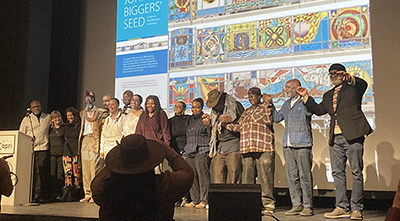
The artists who created the John Biggers Seed Project discuss their work at the community celebration on Dec. 2. Photo by Lisa Austin |
After years of planning, fabricating and anticipation, the John Biggers Seed Project officially opened on Dec. 2, turning a North Minneapolis bridge into a one-of-a-kind celebration of community and culture.
The project consists of a new artistic railing on the Olson Memorial Hwy bridge over I-94, with more than 300 hand-painted, glass enamel panels created in a collaborative effort by 15 local Black artists. Work on the artwork started in 2014, but installation was delayed as plans for the location of light rail evolved.
About 200 people attended the kick-off festivities on Dec. 2. The event started with a tour at the bridge followed by speeches and dance and music performances at the nearby Capri Theater. Many of the artists spoke about the layers of meaning, on both the personal and community levels, to their work.
“We wanted to tell a story so that when you follow the mural there is a story that’s being told,” artist Lee Anders told the Minneapolis Spokesman-Recorder. “There’s water at the bottom of the mural, which is very important here in Minneapolis. There’s the seed, and the bird, and the growth. The mural represents the cycle of Minneapolis. The growth. The destruction and then the rebirth that is happening in North Minneapolis.”
The project intentionally calls back to another large-scale work of art, titled “Celebration of Life,” which was installed on a nearby MnDOT sound wall in 1996 and removed in 2001, when the City of Minneapolis, under a permit with MNDOT, destroyed the art and sound wall to make way for the new Heritage Park housing project. The artist who created “Celebration of Life” was John Biggers, the namesake of the Seed Project.
The project is intended to offer connection and engagement on several levels. For pedestrians crossing the bridge, which links the North Side and downtown, it fosters a stronger sense of walkability and general interest, inviting frequent pauses to take in the art. Connection was also central to the development and creation of the project, as prominent artists Ta-coumba T. Aiken and Seitu Jones led the work and mentored emerging artists, forming a collaborative effort that explored culture, history and sense of place on the Northside. Emerging artists included Willis Bing Davis, Jon Onye LocKard, Mica Lee Anders, Sayge Carroll, Roger Cummings, Patrick Cunningham, Angela Davis, Loretta Day, Christopheraaron Deanes, Adrienne Doyle, Jeremiah Bey Ellison, Jordan Hamilton, Chris Harrison, Esther Osayande and Chris Scott.
The City of Minneapolis Department of Arts & Cultural Affairs managed and funded the project. The panels were fabricated in partnership with the Chicago Avenue Fire Arts Center. MnDOT supported the work by allowing the installation on its right-of-way through the Art on Trunk Highway Right of Way Policy. The policy allows local units of government to donate and maintain public art on the right-of-way. Public art is one way of helping integrate transportation infrastructure with a connection to community and culture. Public art can also help reduce maintenance costs as it often reduces vandalism and graffiti.
“Facilitating a connection between barriers some of our transportation infrastructure has caused in neighborhoods is one of the most important aspects of my work at MnDOT,” said Lisa Austin, Acting Director of the MnDOT Center for Community Connections. “I was honored to participate and witness the healing and celebration that took place at the event.”

The John Biggers Seed Project includes more than 300 hand-painted panels. Photo by Lisa Austin |
|
| |
|

|
 |
TABLE of CONTENTS
 |
Josie Tayse named new safety culture director |
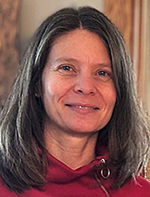
Josie Tayse |
Josie Tayse has been named MnDOT’s new safety culture director.
She will work closely with Propulo on the MnDOT safety strategic plan and with safety professionals throughout the agency in advancing culture around safety and improving safety measures.
Over Tayse’s 19-year career with MnDOT, she has served in several positions around traffic and improving traffic safety, including at RTMC, Metro Traffic and Central Office Traffic.
She is a graduate of the University of Minnesota. |
| |
|

|
 |
TABLE of CONTENTS
 |
Leadership Development Program open enrollment now open |
By Elizabeth Otto, Workforce Development
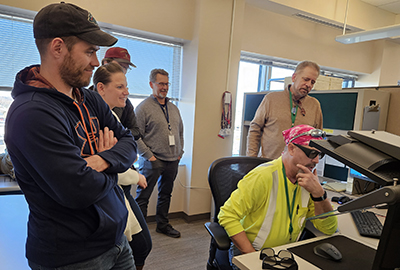
Glen Jentink, Transportation Specialist (far right, standing), demonstrates the use of digital aerial photography in stereo compilation to a group of LDP participants (from left to right: Sean Topp, Brianna Brennan, Jarrod Cicha, Scott Smith, and Todd Ranstrom) during a November 15 training about the Photogrammetry & Remote Sensing Unit. Photo by Elizabeth Otto |
Open enrollment for Group 22 of the Leadership Development Program opened on Jan. 2 and will close on Jan. 31.
The Leadership Development Program, or LDP, is a resource that any MnDOT employee can use to gain skills to become more effective in their current role and develop knowledge and competencies to support career advancement. The agency has produced a new three-minute video about the program, including background information and comments from past participants.
To enroll in the program, complete the Commitment Agreement found under the Enroll tab on the Leadership Development Program iHUB page.
When you enroll in the Leadership Development Program, you will get help at LDP Orientation to compose individualized goals for your professional development. These personalized goals determine what work you will complete during the program year.
Most participants choose to complete LDP-administered training as part of their work toward their goals. This training is offered as a mix of online and in-person classes and experiences to suit the schedules and learning preferences of MnDOT employees across the agency.
LDP participants had opportunities in Fall 2023 to develop leadership competencies in a wide range of LDP-administered classes, including “Business Writing Basics for Professionals” and “Dealing with Conflict Confidently,” “Influence without Authority.” Participants also had the chance to learn more about MnDOT in trainings on topics such as the Central Shop at Ft. Snelling, the Office of Aeronautics at MnDOT and a beginner’s guide to right-of-way acquisition.
To learn more about the requirements of the Leadership Development Program, attend an upcoming LDP Info Session. No registration is required for these sessions, and each session will cover the same information. Click the correct Teams link below to join the session you prefer:
Please email the LDP Team if you have any questions about the Leadership Development Program or the upcoming information sessions.
|
This video explains the LDP program. Video produced by MnDOT Video Services |
|
| |
|

|
 |
TABLE of CONTENTS
 |
Safety perception surveys to help MnDOT identify strengths, work on weaknesses |
By Keith Juliar, emergency management, workers compensation and safety manager; Rod Starkey, safety culture coordinator; and Ben Bloom, safety director
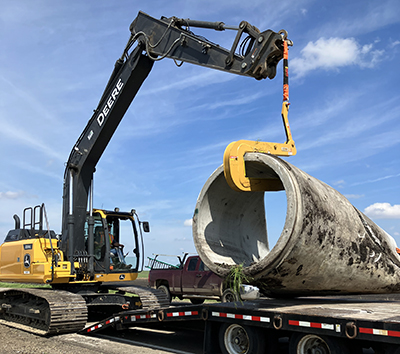
MnDOT crews working in District 7. Submitted photo |
MnDOT recently participated in two statewide safety perception surveys in which employees had the opportunity to share their opinions and comments. The information gathered through these surveys will contribute to the agency’s analyses and assist in developing action plans to improve MnDOT’s safety culture.
The PMA safety perception survey and the Propulo survey are posted on the Workplace Safety Planner. Both surveys will help the agency create a 3-5 year road map; the strategies in the action plan will help move MnDOT towards a holistic safety strategic plan and culture.
The PMA survey results will show the agency where it was in 2017 as a baseline, where it is now and where it wants to be for safety culture.
Overall, MnDOT’s PMA score was 3.8 out 5. (The average for all Minnesota state agencies was 3.66.) A score of 4.0 or more suggests a positive safety culture.
The survey was divided into seven safety culture indicators, with MnDOT receiving the following scores:
- Employee safety involvement: 3.75
- Safe work environment: 3.75
- Workplace safety norms: 3.98
- Safety supervision: 3.80
- Organizational safety leadership: 3.80
- Safety training and development: 3.74
- Job satisfaction: 3.76
- Average score across all categories: 3.80
The agency scored highest in the three questions below:
- It is OK to remind or encourage co-workers to work safely (4.12)
- I clearly understand our safety policies and expectations (4.11)
- There is an expectation that work will be performed safety (4.09)
The agency had the lowest scores with these three questions:
- Formal safety inspections are performed on our work sites and facilities (3.53)
- Lessons learned from accident investigations are shared and used to make our workplace safer (3.46)
- Safety performance is considered in performance appraisals and promotions (3.43)
Over the past three years, MnDOT has averaged 376 workplace injuries each year. The individuals getting hurt are our fellow employees, coworkers and friends, and it’s essential that we work to create a culture where employee safety is a very high priority.
These survey results will help MnDOT identify the areas of strength we can build from and areas where additional attention is needed to build a stronger safety culture. In the coming months, MnDOT will work with the Propulo team to combine and analyze the survey results and develop and prioritize strategies. To ensure we all go home safely at the end of the workday, please take the time to consider safety in all your actions. Also, look for additional communication about our continued efforts to improve safety culture at MnDOT. |
| |
|

|
 |
TABLE of CONTENTS
 |
On the Job: Melissa Bartlett connects MnDOT and the public |
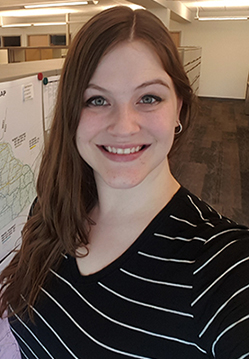
Melissa Bartlett |
By Doug Mack
MnDOT’s interactions with the broader public go beyond the planning and completion of specific construction projects. They also include other topics like Adopt a Highway and Damage Restitution, two lesser-known but essential areas that require the hard work of Melissa Bartlett and her colleagues.
How long have you been at MnDOT and in what positions?
I've worked for MnDOT since Nov. 2021, so just over two years. I began in District 6 as an office and administrative specialist and the Adopt a Highway coordinator, then became the district's Damage Restitution coordinator, and throughout both of those roles I also performed many administrative support tasks in the Rochester office. Now I work as part of Central Office as the statewide Adopt a Highway coordinator and I assist with the statewide Damage Restitution program as well.
What are your day-to-day tasks? Do they change throughout the year?
I answer calls, emails and Teams calls regarding Adopt a Highway, Adopt a Rest Area and Damage Restitution questions, requests and research. I talk to all sorts of people from the various districts and from CO departments about Adopt a Highway questions and concerns. Lately I've been researching points of data sporadically each month for a publicly accessible GIS map MNIT is developing for Adopt a Highway. When I am not working on Adopt a Highway, I check over and submit Damage Restitution claims turned in by the district coordinators for Cash & Collections to be able to bill. I also process some invoices each month for the Office of Maintenance. The thing that changes about these duties throughout a year is how much time is needed for each task. Adopt a Highway's busy season is from spring to autumn when the volunteer groups are out picking litter, so my focus is more centered on Adopt a Highway matters. Damage Restitution's busy season used to be from late autumn to early spring due to snow and ice, however it does feel like lately there's no off-season anymore.
How does your work fit into the broader work of MnDOT?
I believe Adopt a Highway positively helps the agency as a major public-facing program. It offers a volunteer-based and environmentally helpful opportunity for people to partake in. I know that the work my coworkers and I do in Damage Restitution helps bring funds back to the districts for their hard work when they repair out property that is struck by motorists. My hope is that my work with Adopt a Highway helps the districts have less work to do cleaning up the roadsides, by having public volunteers do some of it. I also hope that my work will help the shops and truck stations receive more reasonable and clear requests when their work is needed for the programs I assist.
What the most challenging and rewarding parts of your job?
The most challenging part of my job right now has probably been researching data for the Adopt a Highway GIS map. It involves checking a lot of different sources of information to piece together what I'm trying to find. It's a good kind of challenge in my opinion, as I like investigating and working with data archives, and this project feels like solving lots of little puzzles about how adoptable sections of highway fit together. The most rewarding part of my job is getting to expand the skills I got from being trained as an Adopt a Highway and Damage Restitution district coordinator to help work out situations with the current district coordinators in those programs. It feels great to be able to offer help and to further my own understanding from all the smart, kind people connected to the programs.
How has your job changed since your first started?
I've been in this role only six months, but I think what changed most about it was that Ann McLellan retired and so my coworkers and I adapted to a new way of doing things without a direct supervisor. As a result, I think it made me work harder on decision-making and taking charge of Adopt a Highway so that the program could still be supported with care. This could not have been possible without Teisha Long and Amanda Molnar helping me out these few months. They freely and patiently shared their knowledge and supported me as I figured out my role in the office. Jed Falgren (sort of our temporary direct supervisor), too, has been more than happy to encourage me in ventures like the Leadership Development Program, which has also changed my job since starting because I'm getting to spend more time learning about the agency and improving myself.
Is there anything about your job that might surprise other people (either inside or outside MnDOT)?
I guess what has been surprising to my friends and family (the ones who know about what I do) think it's neat that I work with and talk to so many people in so many roles throughout Minnesota for matters to do with Adopt a Highway and Damage Restitution!
What are your interests or hobbies outside your work with MnDOT?
I like to spend time with family and friends as often as possible. I like to cook, bake, sew, knit, crochet, read and play video games.
Do you or a co-worker have an interesting job to share with readers? Send us your ideas, and we’ll contact you for more information.
Recent employee profiles:
|
| |
|

|
 |
TABLE of CONTENTS
 |
Josie Birch honored with Rising Star award |
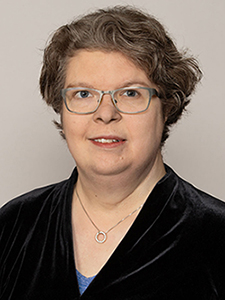
Josie Birch was selected as one of this year's Rising Stars. Submitted photo |
By Doug Mack
Josie Birch, a MNIT program manager who works on disaster recovery plans for MnDOT, was selected as one of this year's Rising Stars by Route Fifty and Nextgov/FCW. The award recognizes individuals in the government IT community who share a sense of duty, commitment to excellence and devotion to public service. Birch was one of 15 honorees from across the country, including IT professionals from federal agencies and local governments.
Since March 2023, Birch has been working with MnDOT to develop, test and maintain disaster recovery plans for the agency’s 57 high- and medium-priority applications.
“This is an award for the team,” Birch said in an interview posted on the MNIT website. “It is a testament to the people of MNIT and our partners at MnDOT. It's a recognition of the incredible talents and initiative of everyone involved in the MnDOT disaster recovery.”
|
| |
|

|
 |
TABLE of CONTENTS
 |
State of Minnesota Martin Luther King, Jr. Day Celebration to take place on Jan. 11-15 |
By Doug Mack
The 38th Annual State of Minnesota Martin Luther King, Jr. Day Celebration will be held on Jan. 11-15 with a variety of events in the Twin Cities area and a day of service around the state. MnDOT is one of several agencies participating as a platinum-level sponsor for the celebration and also participating in one of the events, the STEM Career Fair, on Jan. 12.
Other major components of the celebration include the Achieving the Dream Conference on Jan. 11, STEM events at the Science Museum and the 3M Innovation Center, and, on Jan. 15, the official Martin Luther King, Jr. Day Celebration, hosted by Gov. Walz and Lt. Gov. Flanagan at the Ordway Center in St. Paul.
To learn more about the events, visit the MLK Day page on the Minnesota Office of Equity, Opportunity and Accessibility website.
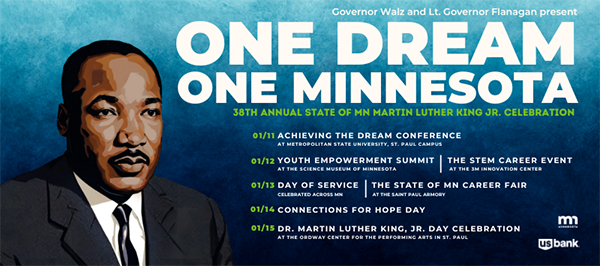
Event announcement from the Minnesota Office of Equity, Opportunity and Accessibility..
|
|
| |
|

|
 |
TABLE of CONTENTS
 |
History Highlight: Building the Lowry Hill Tunnel |
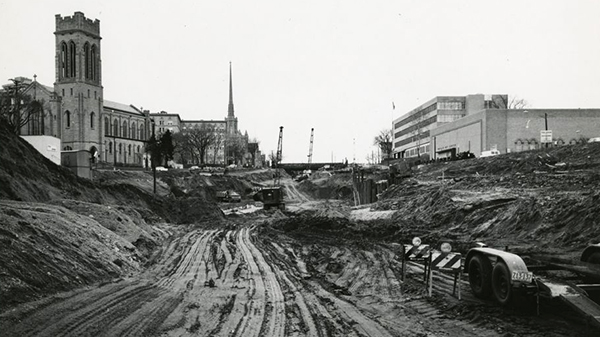
This black-and-white photograph, from 1968, shows construction of the Lowry Hill tunnel and interchange near downtown Minneapolis. This view is looking north, with the Walker Art Center and St. Mark's Episcopal Cathedral visible on either side of the road. Special thanks to Micaela Kranz, Office of Research & Innovation, for suggesting the History Highlight feature.. Photo from the Minnesota Digital Library
|
|
| |
|

|
 |
TABLE of CONTENTS
|
Name That Place Puzzler #16 |
By Doug Mack
Can you name the place pictured below? The ground-level photo is from Google and the satellite image is from the 511 website and app.
If you think you know the answer, email Newsline editor Doug Mack. The first three people to submit the correct answer will receive the fame and glory of having their names listed in the next issue of Newsline.
Answer to the last Puzzler: World’s Largest Turkey on Hwy. 87 in Frazee. The first people to get it right were Patrick Gilbertson (Office of Land Management), Brian Unbehaun (Property Conveyance), Scott Haataja (District 4), Bryan Christensen (District 4) and Adrienne Bond (Office of Civil Rights). Congrats to them and thanks to everyone who played!
A peek behind the scenes of the Puzzler: There was a three-way tie for third place—we count all answers that arrive in the same minute. In this case, Newsline went out at 3:53 p.m. and the first answer arrived at 3:57 p.m., followed by the second at 3:58 p.m. and three more at 3:59 p.m.
If you know a place that would make a good Puzzler, please get in touch!
|
 |
|
|
|



